Women’s knowledge and preferences for midwife’s role within the range of maternal care professionals in Makkah,Saudi Arabia
2023-03-07MalakYousefBughdadiAfnanAbdulatifALbokhary
Malak Yousef Bughdadi,Afnan Abdulatif ALbokhary
1Ministry of Health,Kingdom of Saudi Arabia,Asshawqiya 8003,Makkah,Saudi Arabia.2Faculty of Nursing,Department of Midwifery Practice,Umm Al-Qura University,Alabdeyah Makkah 24351,Saudi Arabia.
Abstract Background: The midwife plays a critical role in health counselling and education,not just for women but also for their families and communities.At the current time,with the growth of the midwifery workforce globally,there is still a lack of understanding regarding the full scope and role of the midwife. Aim: To evaluate the current situation of knowledge of midwives’ role among women in Makkah.In addition,this study identifies the effect of women’s knowledge on their preferences for receiving maternity care from health professionals. Methods: This study employed a descriptive quantitative cross-sectional method.The total resultant sample size(N) equalled 379 global respondents,of which 306,with a response rate = of 80.73% completed the entire survey as requested.An electronic questionnaire in the Arabic language was used in this study. Results: Results revealed that most women had incorrect knowledge regarding three aspects of the midwives’roles during pregnancy 53.9%,labour 52.8% and childbirth 61.9%.Also,results presented that most women preferred obstetricians to follow up on an uncomplicated pregnancy,labour,childbirth,and maternity care 69.6%,53.9%,64.7% and 46.1%,respectively.The study found that the women’s knowledge about midwives’ roles affects their preferences for healthcare professionals in receiving maternity care (P < 0.05). Conclusion: Responses showed that most participants had no experience and had negative views about midwives’roles.Thus,it would affect their health professionals’ preferences for receiving maternity care.Therefore,midwifery services and maternity care professionals should prioritize educating women about midwives’ competencies in maternity care.
Keywords:women; knowledge; preferences; midwife;maternal care; Makkah;Saudi Arabia
Background
Midwives have long been recognized to have a significant role in maternal care worldwide.Midwives are multidimensional healthcare providers with diverse skills and knowledge,extending from prenatal care through education and research [1].Furthermore,the evidence indicates that high-quality midwifery care is associated with significant and consistent decreases in maternal and newborn mortality [2].
The midwife plays a critical role in health counselling and education,not just for women but also for their families and communities.This work should include prenatal education and preparation for motherhood,women’s health,sexual and reproductive health,and child care.Midwives may work in various settings,including the home,the community,hospitals,clinics,and health units [3,4].Recent evidence shows midwives act as influential and essential core members of the health workforce for sexual,reproductive,maternity,infant,and adolescent health.They have proven critical in achieving meaningful progress toward several of the 2030 Agenda for Sustainable Development’s goals and targets [5].
The Global Strategy for Women’s,Children’s and Adolescents’Health (2016–2030) emphasizes the critical nature of each woman,child,and adolescent’s health and welfare,including access to essential interventions and an effective health workforce [6].However,the Lancet 2021 series on midwifery has shown that the awareness of midwives’ capacity to contribute to this global agenda has grown over the last decade [2].However,awareness regarding midwives’ competencies can be limited.This lack of understanding can negatively affect perceptions and restrict access to high-quality maternity care,particularly in places where midwifery care is being introduced [7].In addition,previous studies showed that women’s preference for selecting health professionals for maternity care is based primarily on being informed about their care and the care choices they receive [8,9].
The public’s knowledge regarding midwives’ roles and competencies was poor in the literature,“especially among women,”despite the growth of the midwifery workforce over the years worldwide.Therefore,the need to understand the women’s perception and knowledge of the midwife’s role may influence access to maternity care.Thus,the study aims to evaluate the current knowledge of midwives’ role among women in Makkah.In addition,this study identifies the effect of women’s knowledge on their preferences for receiving maternity care from health professionals.
Methods
Research design
This study employed a quantitative cross-sectional method to evaluate the current knowledge of midwives’ role among women in Makkah and identify the effect of women’s knowledge on their preferences for receiving maternity care from health professionals.
Instrument of data collection
A descriptive modified electronic questionnaire in the Arabic language was used in this study.The questionnaire takes between 10–15 minutes to complete and is composed of 4 parts; demographic data,the preferences of Saudi women for their health professional in an uncomplicated pregnancy,the women’s thoughts about midwives,and the women’s opinions about the central health professionals to follow up an uncomplicated pregnancy.
The questionnaire covered sociodemographic data such as age,nationality,level of education,work status and history of gravida,three multiple-choice questions regarding women’s preferences for their health professional in an uncomplicated pregnancy.Thirty-six questions on Likert scales with an option of selecting 0 to 5.In addition,one open-ended question regarding the women’s thoughts about midwives and the women’s opinions about the central health professionals to follow up on an uncomplicated pregnancy was developed based on the study conducted in Kansas by the tool’s developer Elizalde [8].The tool’s developers obtained informed consent as permission to use the instruments.
Instrument validity and reliability
Reliability.In this study,Cronbach’s alpha coefficient was calculated by using Statistical Package for the Social Sciences version 21.The tool’s reliability through their internal consistency indicates that Cronbach’s alpha was 0.955(for 35 items).
Validity.In this study,the construct validity of the knowledge scale illustrated high construct validity as all items had substantially higher correlations,with the total scale score ranging between 0.54 r to 0.87 r.The research instrument’s face validity was ensured by reviewing the questionnaire with two staff members with experience(professors)at Umm Al-Qura University.After completing the questionnaire,it was translated into Arabic and presented in its modified form to a group of arbitrators.After retrieving the arbitrated version,their notes were discussed with the supervisor’s Excellency.In light of some arbitrators’ suggestions,the researcher reworded the questionnaire,where some of the coefficient values were high,as they scored above 0.90; this value indicates the availability of a high degree of internal consistency validity for the questionnaire’s items.
Data collection procedure
The researcher visited the selected settings three days in the hospital and two days in primary healthcare centers,not-included weekends.Study participants were selected,and face-to-face interviews in the maternity clinic’s waiting room to collect the appropriate sample size because usually,the waiting rooms gather most of the clinic’s visitors in the maternity and child hospital and Alzaher healthcare Centre from the Makkah region.
Participants were self-selected to participate in a study by scanning the barcode and going to the link into the electronic survey indicated on the invitation to participate.After reading and agreeing to an online consent form that explained the nature of the study and stated the participant’s rights,the participants were led to the first part of the survey and then to the next part.In this study’s context,women were recruited into the electronic survey respondent pool and represented a broad range of individuals.The researchers developed the survey on the electronic survey with a personal account and converted the electronic questionnaire’s link to a barcode.The barcode was printed on paper and distributed from February 01 2022 to May 01 2022.
Research setting
The city of Makkah was chosen for this research.
Maternity and child hospital Makkah,Saudi Arabia: the new hospital,which is located next to King Abdullah medical city on the Makkah-Taif road,has a total bed capacity of 621 beds,with 507 beds for clinical sections,115 beds for intensive care sections,34 beds for emergency sections,and 23 beds for delivery rooms [10].
Alzaher healthcare centre: Al Zaher healthcare centre is one of the urgent care centers in Makkah Al mukkaramah and is accredited by Central Board for Accreditation of Healthcare Institutions for implementing quality and patient safety standards.The healthcare centre adopts the double-shift system,the morning shift from 8 to 4 and the evening shift from 3 to 12.
Research population
The population of interest for this study was composed of women of reproductive age(between 18 and 49 years old).
The targeted population consisted of all women of reproductive age(between 18 and 49 years old) visiting maternity clinics of the maternity and child hospital and Alzaher healthcare centre from the Makkah region during the study’s time.
Sample size
In this study,the confidence interval used was a margin of error is 5%and a 95% confidence level.The total population was 1,496 women,calculated by the sum of the total women visiting maternity clinics during three months from the selected hospitals,the maternity and child hospital and Alzaher healthcare centre.The sample size was calculated using an online calculator.The sample size was calculated using this formula by Kerjcie and Morgan (1970):
S = (x^2 N_P(1 –P))/(d^2 (N –1) ) + x^2P(1 –P) [11].
This study utilized convenience sampling techniques to select the most beneficial research participants.As a result,306 women were sampled as primary research participants (Figure 1).
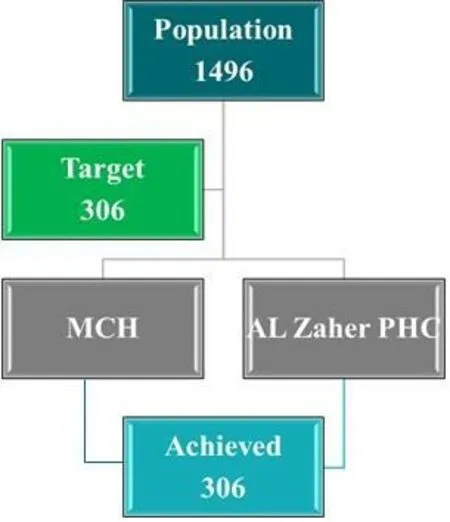
Figure 1 Sample size.MCH,maternity and child hospital; AL,Alzaher healthcare centers; PHC,primary healthcare centers.
Sampling method
The researcher in this study used convenience sampling.A convenience sample is a group of participants available for the study.
Inclusion and exclusion criteria
Inclusion criteria.1.Women who visit maternity clinics in 1 centre in Makkah and one hospital.2.Women of reproductive age (between 18–49 years old) will be included in the study.3.Able to read and write Arabic or English.
Exclusion criteria.1.Women older than 50-year-old.2.Women surveyed as a pilot study will be excluded.3.Existing severe pregnancy or maternal or infant health complications.4.Inability to consent.
Data analysis methods
The data collected were analyzed with International Business Machines Corporation’s Statistical Package for the Social Sciences version 21.Microsoft Word and Excel were used to generate graphs and tables.Descriptive statistics,including frequency and distribution,describe different characteristics.The overall knowledge score for the entire sample was expressed as the percentage of correct answers.For the open-ended question (opinions about the midwife’s care),transcripts were read and re-read by the researcher and initial codes were generated and grouped into themes.Then,the themes were reviewed and refined through repetition.The process is undertaken by the researcher and presented in frequencies and percentages.
Inferential statistical analyses were conducted to examine which demographic and history of gravida or independent variables of the study(age,nationality,level of education,employment status,number of births,type of delivery and the health professional who delivers the women’s last-child) predicted the dependent variables which were divided into two parts:women’knowledge and preference.Analysis of variance (ANOVA) and t-tests were utilized to identify the differences in women’s knowledge scores.Multiple regression analysis was run to predict the correct knowledge from demographics,gravida history,and women’s preferences.Values ofP< 0.05 are considered significant.
Ethical consideration
Permission to conduct the study was obtained from Umm Al- Qura University.The setting ethics committee ethically approved the research (Table 1).The subject was asked to participate,and oral consent to participate in the study was obtained from them.In addition,they were reassured that participation in this study was voluntary.Confidentiality and privacy were maintained by data coding to eliminate identifying data with personal information.
Results
Table 2 shows the demographics and personal characteristics of the study participants.

Table 1 Ethical approval
As shown in Table 3 below,more than one-third of the studied sample (41.5%) have given birth to three or more children,whilst 24.5% of the participants have not given birth.Regarding the type of delivery of the women’s last birth,60.6 % of the sample gave birth to their last child vaginally,whereas 39.4 % by a caesarean section.
Table 4 shows the women’s knowledge of midwives’ roles.Almost half of the sample has incorrect knowledge of the midwives’ role in diagnosing the pregnancy and prescribing medicaments related to pregnancy,41.2% and 47.4%,respectively.Also,the table presents that more than one-third of participants have incorrect knowledge of the midwives’ role in informing about the progress of the pregnancy,prescribing examinations necessary to evaluate the progress of pregnancy and interpreting blood results related to pregnancy 36.9%,39.9%and 38.6%,respectively.However,most(85.3%) of the sample had incorrect knowledge regarding the midwife’s role in vaccinating the pregnant woman.
Women’s knowledge of midwives’roles and competencies during labour
Table 5 demonstrates that most of the participants were aware of the role of midwives during labour.However,the majority of the sample(73.2%) incorrectly selected the place of epidural anaesthesia as the role of the midwife.
Women’s knowledge of midwives’roles and competencies during childbirth
Table 6 illustrates that women were aware of nine out of seventeen midwives’roles during childbirth;more than two-thirds of the women were aware that midwives could perform non-pharmacological pain management techniques.Most of the sample had incorrect responses to eight statements on midwife roles during childbirth.
Women’s knowledge of other midwives’roles and competencies
Table 7 shows that most of the participants were aware those midwives could have certain roles and competencies.However,more than half of women considered performing an abortion and amniocentesis as roles of the midwife,76.1%and 76.5%,respectively.Figure 2 presents that most of the participants had incorrect knowledge regarding three subscales of the midwives’ roles and competencies during pregnancy 53.9%,labour 52.8% and childbirth 61.9%.On the other hand,50.4% of the women had correct knowledge of the other midwives’roles and competencies.

Table 3 History of gravida(N= 231)

Table 4 Responses to the pregnancy subscale reflecting knowledge of midwives’ roles

Table 5 Responses to the labour subscale reflecting knowledge of midwives’ roles
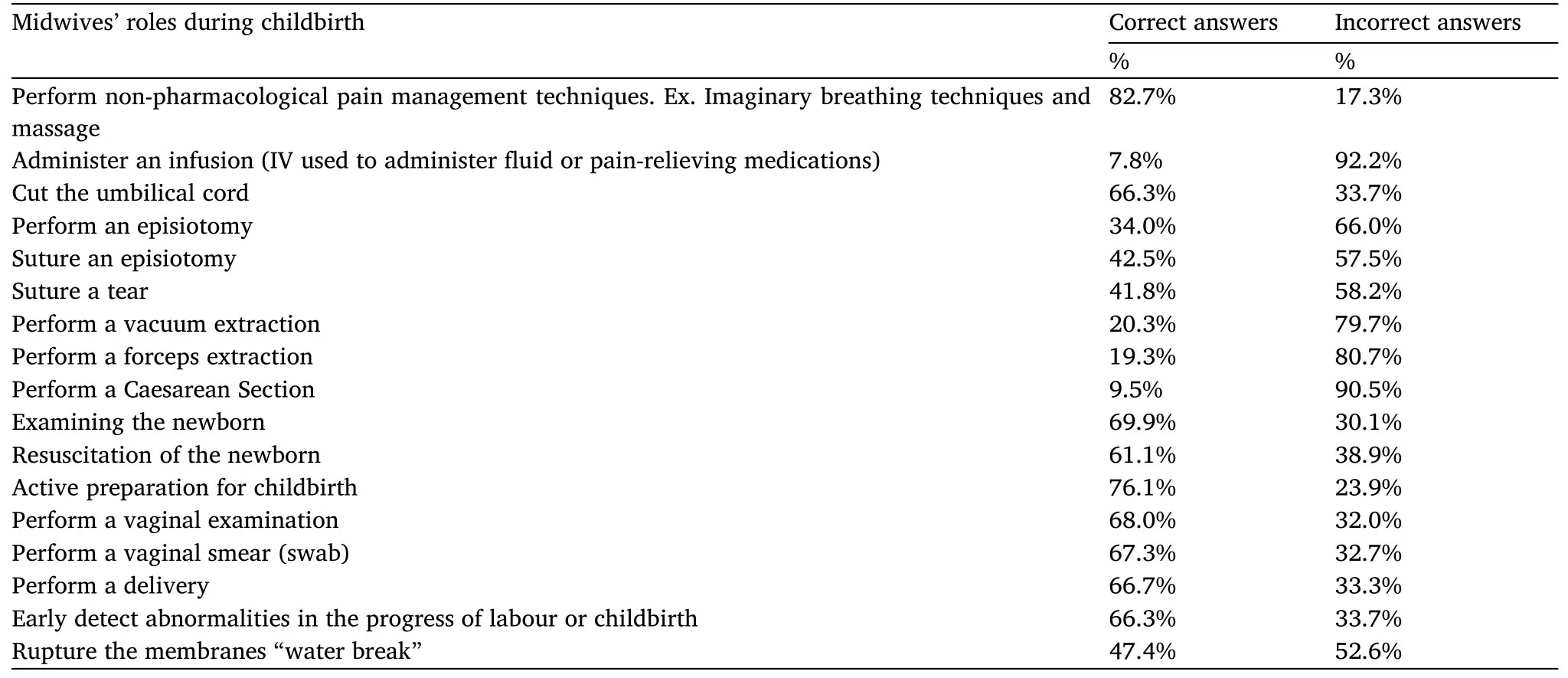
Table 6 Responses to the childbirth subscale reflecting knowledge of midwives’ roles

Table 7 Responses to the other midwives’roles and competencies
The preferences of women for their health professionals for receiving maternity care
The majority (73.2%) of the participants preferred female healthcare professionals for receiving maternity care,whilst only 9.5% of the sample preferred male healthcare professionals for receiving maternity care.Also,the figure presents that 17.3% of participants had no preference for the gender of healthcare professionals for receiving maternity care.
Figure 3 presents that most women preferred obstetricians to follow up an uncomplicated pregnancy,labour,childbirth,and maternity care 69.6%,53.9%,64.7% and 46.1%,respectively.On the other hand,almost one-third of the sample preferred midwives to follow up on an uncomplicated pregnancy,labour,childbirth,and maternity care 10.8%,24.5%,19.9% and 28.8%,respectively.
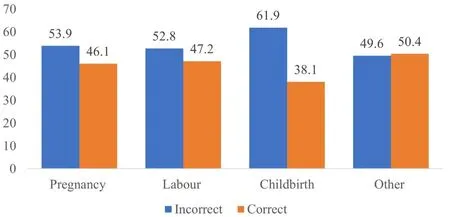
Figure 2 Responses to subscales reflecting women’s knowledge of midwives’roles and competencies
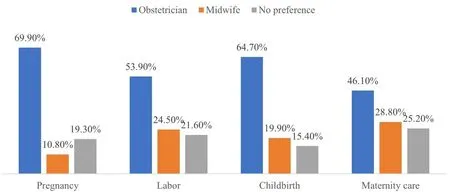
Figure 3 Preferences of women for their health professional for receiving maternity care
Inferential statistics
The results of the ANOVA test demonstrated that the mean of women’s knowledge regarding midwives’ roles was significantly higher among employed women (Mean (M) = 3.35,standard deviation (SD) =0.77) (P< 0.05).On the other hand,it was found that neither age,nationality,or level of education was significantly associated with variations in the mean scores for women’s knowledge regarding midwives’ roles (P> 0.05).Also,the results of the ANOVA test revealed that the women’s opinions about the midwives’ roles were significantly associated with variations in the mean scores for women’s knowledge regarding midwives’ roles (P< 0.05).
The results demonstrated that the mean of women’s knowledge regarding midwives’ roles was significantly higher among employed women (M =3.35,SD =0.77) (P<0.05).On the other hand,it was found that neither age,nationality,or level of education was significantly associated with variations in the mean scores for women’s knowledge regarding midwives’ roles (P> 0.05),as shown in Table 8.
With respect to the participants’ history of gravida,there were no significant differences among participants regarding variations in women’s total knowledge scores.However,these differences were not statistically significant (P>0.05) (Table 9).
Table 10 showed the results revealed that the mean total knowledge scores were significantly higher among women who preferred midwifeas their health care professional to follow up pregnancy (M = 3.69,SD = 0.65) than those who preferred obstetrician (M = 3.11,SD =0.96) (P< 0.05).Moreover,it was found that women who preferred midwives as their health care professionals to follow up on childbirth were significantly more aware of midwives’ roles (M = 3.58,SD =0.61) compared to women who preferred obstetricians(M = 3.05,SD= 0.98) (P< 0.05).

Table 8 Women’s knowledge of midwives’roles according to their demographic characteristics(N = 306)

Table 9 Women’s knowledge of midwives’roles according to their gravida history (N = 231)
Multiple regression analysis
Multiple regression was run to predict the correct knowledge from demographic,gravida history and women’s preferences.These variables statistically significantly predicted the women’s correct answers,F (12,293) = 2.357,P< 0.007,R2 = 0.088.Only three variables added statistically significantly to the prediction,employment status,women’s preference for health professionals in childbirth and women’s preference for the health professionals’genderP<0.05 (Table 11).
In this table,R can be considered to be one measure of the quality of the prediction of the dependent variable: in this case,correct answers of the women’s knowledge.A value of 0.297 indicates an acceptable level of prediction.The “R square” column represents the R2 value,the proportion of variance in the dependent variable that can be explained by the independent variables(demographic,gravida history and women’s preferences variables).The value of 0.088 that our independent variables explain 0.88% of the variability of our dependent variable.Also,the table shows that the independent variables statistically significantly predict the dependent variable,F(12,293) = 1.708,P<0.005 (i.e.,the regression model is a good fit for the data).
Analysis of open-ended questions
The first asked respondents about the reasons for their preferences for the health professional’s gender for receiving maternity care (Table 12).The second asked participants about their opinions on midwives’roles were analyzed and grouped into categories.These categories were quantified into a table and are discussed below (Table 13).
Table 12 demonstrates women’s reasons for preferences of the health professional’s gender for receiving maternity care.The table shows that most participants (78.1%) had no reasons or gender bias when selecting health professionals for maternity care.However,19%of women surveyed reported preferring a female over a male(n=29,9.5%)believed that“females are culturally accepted as maternity care providers because they are mothers and understand the mother” (n=12,3.9%) believed “Females are empathetic and understanding”,and(n = 17,5.6%) believed “intimate examinations can be embarrassing or distressing for women by male doctors”.On the other hand,only 9(2.9%) women trusted the male health professional because he was strict and had more experience and knowledge,being more kind,compassionate and patient with the woman.
Table 13 illustrated that more than one-third (n = 130,42.5%) ofthe sample had no experience and knowledge about midwives’ roles.Whereas 11.8% of the studied participants had a positive experience with maternity care provided by the midwife.However,participants(n = 39,12.7%) believed that “midwives assist physicians during childbirth,receive newborns during childbirth,give more emotional support,and be more patient and tolerant”.The others(n=27,8.8%)believed that “a midwife is a physician’s assistant who assists with normal vaginal deliveries”.

Table 11 Multiple regression analysis

Table 12 The response to open-ended questions
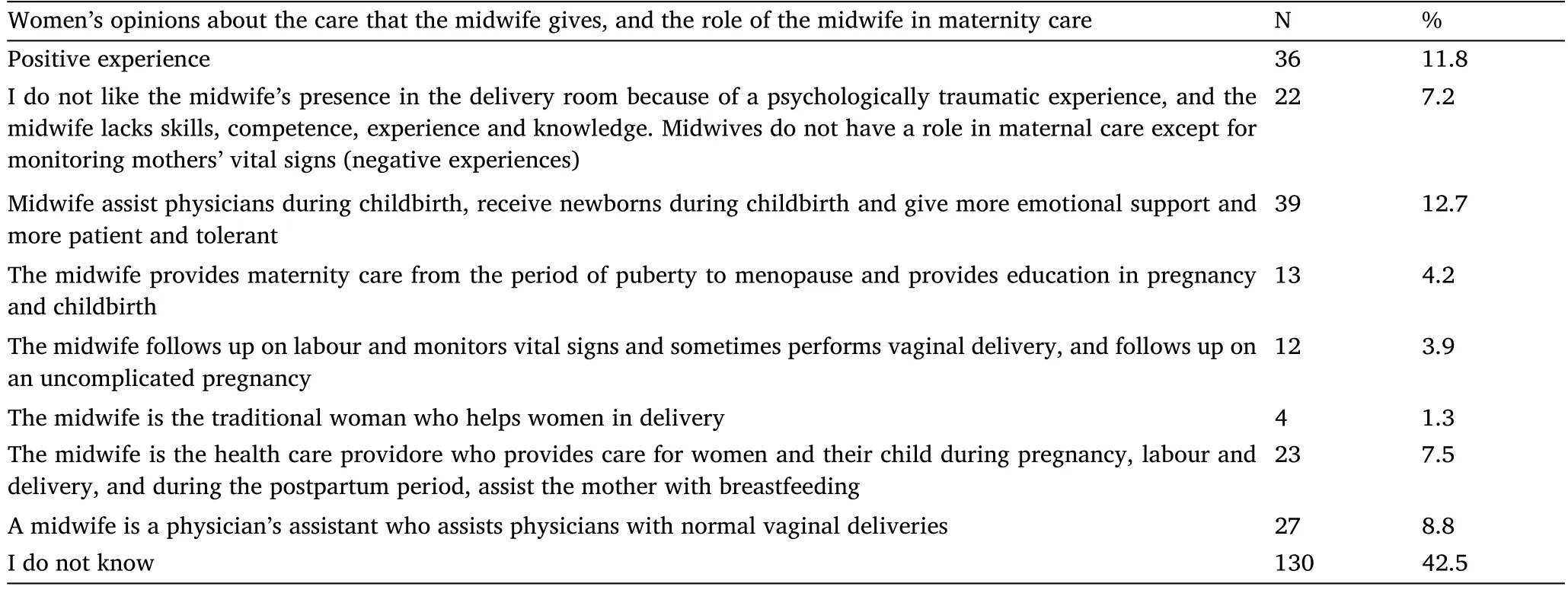
Table 13 The women’s opinions about the care that the midwife gives,and the role of the midwife in maternity care
The results in Table 14 demonstrated that the mean of women’s total knowledge regarding midwives’ roles was significantly higher among participants who believed that “the midwife provides maternity care from the period of puberty to menopause and provides education in pregnancy and childbirth”(M=3.73,SD=0.58).While the lowest mean was detected in participants who responded to the question with “I do not know” (M = 2.94,SD = 1.21),as the table shows that the women’s opinions about the midwives’ roles were significantly associated with variations in the mean scores for women’s total knowledge regarding midwives’roles (P< 0.05).
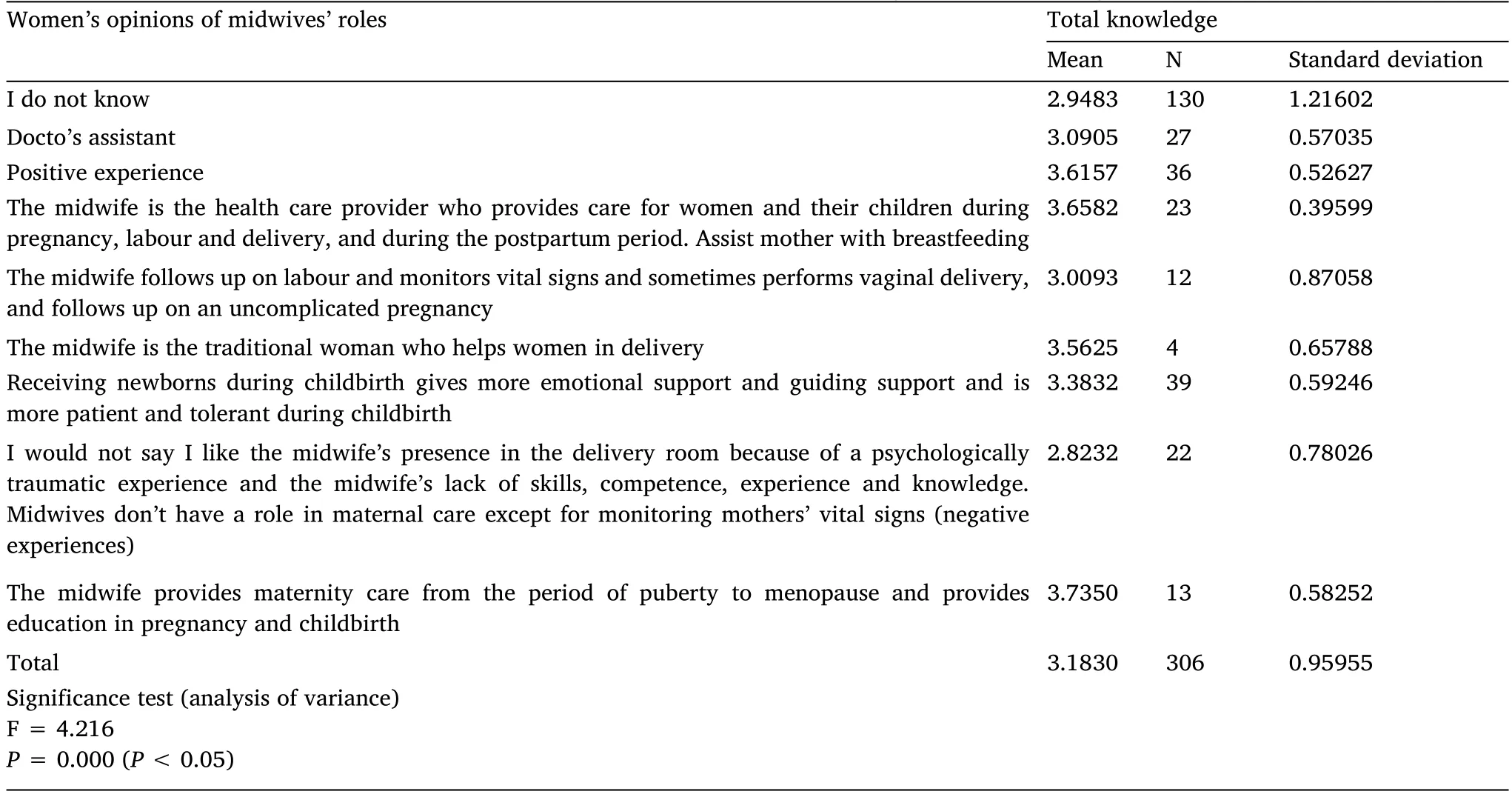
Table 14 Women’s opinions of midwives’ roles according to their knowledge (N= 306)
Discussion
Women’s knowledge and perception of midwives’ roles and competencies
Based on the findings obtained from this study,the mean total score of the overall knowledge among women was 3.18,which indicates that,on average,the women reported having an average knowledge of midwives’ roles.
According to various studies,women worldwide are unaware of the midwife’s role in maternity care.In line with the study findings,in Germany,Mattern and others (2017) found that women lacked knowledge of midwives’ scope of practice and competencies [12].Similar findings from two studies,Thailand by Liblub,et al.and Australia by McKellar,Brown,Adelson and Medway,found a lack of understanding regarding midwives’ high skill and expertise [7,13].However,in contrast with previous findings,in the United States,a study conducted on the general public found that most participants had sufficient knowledge about midwives’ roles in maternity care[8].Regarding the women’s opinions and experiences about the care that the midwife gives and the midwives’ roles in maternity care,in the present study,the results of the open-ended question illustrated that 11.8% of the studied participants had a positive experience with maternity care that provided by the midwife.On the other hand,the others (n = 39,12.7%) believed that “midwives assist physicians during childbirth,receive newborns during childbirth,give more emotional support,and be more patient and tolerant”.These findings are in the same line with previous studies; in the United Kingdom,a study found that women reported a positive experience with midwife care.They felt empowered by the midwife’ providing information,education,and guidance [14].Similar findings were in Iran,Sweden,Belgium and the United Kingdom [15–18].
The evidence revealed that women at risk of preterm birth have a similar positive experience with midwifery care than women with uncomplicated pregnancies.In the United Kingdom,Fernandez Turienzo,Silverio,Coxon,Brigante,Seed,Shennan,Sandall and Groupfound that women with preterm birth risk factors had more favourable attachment experiences with their newborns and had better physical health postpartum [18].In addition,women at higher risk of preterm birth who received midwifery continuity of care were more likely to report higher levels of trust,safety,and care quality.The key results that researchers agreed on were that women reported positive experiences of midwife-led care,such as improved empowerment and satisfaction in women with prenatal,intrapartum,and postpartum care for women at low risk of medical problems.
The current study’s results revealed that twenty-two (7.2%) women reported negative experiences regarding midwife care.They stated that I do not like the midwife’s presence in the delivery room because of a psychologically traumatic experience.The midwife lacks skills,competence,experience and knowledge.Therefore,the women believed midwives do not have a role in maternal care except monitoring mothers’ vital signs.Moreover,some recent studies on previous delivery experiences studied these influences on the choice of health professionals in maternity care.This is relevant to this study because many women appeared to have negative perceptions of midwives.Khresheh and colleagues (2019) reported that the most common adverse experiences during labour among women were dismissive manners and physical and empathic abandonment by midwives.
On the other hand,women expected midwives to pay attention to what they had to say and respect them [19].On the other hand,women expected midwives to pay attention to what they had to say,respect them,and be genuinely there for them when they needed them[20].However,if women’s preferences for healthcare professionals in maternity care are related to previous experiences,midwives must consider this in Saudi Arabia.
In the current study,27 women(8.8%)believed that“a midwife is a physician’s assistant who assists with normal vaginal deliveries”.Similar findings from Thailand,the study reported that Thai women’s perceptions of the midwife’s role during labour included supporting,encouraging,pushing,and assessing physicians in the labour room rather than performing procedures [13].The previous findings could explain medical practitioners’ prominent status,limiting midwives’autonomy in their scope of practice during labour and delivery.However,the results indicate that the women’s opinions are consistent with the medical paradigm.The physician is considered the primary healthcare provider and a professional skilled in diagnosis and treatment [13].
Regarding the association between nurses’opinions and experiences with their knowledge of midwives’ roles,the results revealed that the women’s opinions were significantly associated with variations in the mean scores for women’s knowledge regarding midwives’ roles (P<0.05).Although knowledge and perception of midwives’ roles might be limited in the literature,this lack of understanding can influence perceptions and impede access to high-quality maternity care,especially in places where midwifery is introduced [8].
It was also identified that the mean knowledge scores were higher among women who had two births (M = 3.26,SD = 0.75),women who had a caesarean section(M=3.30,SD=0.77),and women who have been delivered their baby by obstetric nurses (M = 3.42,SD =0.53).However,these differences were not statistically significant (P> 0.05).The current study results are supported by the study’s findings by Elizalde,who reported that there were no statistically significant differences among participants’ knowledge of midwives’roles regarding their demographic characteristics [8].
Women’s preferences of health professionals for receiving maternity care
Understanding the women’s perception and knowledge of the midwife’ role may influence access to maternity care.According to Alanazy and Brown,the average percentage of women who do not attend their visits to maternal care is 47.9% [21].The evidence indicated that the midwife’s role significantly influences maternal and child morbidity and mortality.Therefore,this study was undertaken to gain a deeper understanding of the impact of woman’s awareness of midwives’ roles and their experiences with midwife-led care on their preferences for receiving maternity care from health professionals.According to evidence,women’s preferences for choosing health professionals for maternity care have been primarily dependent on being informed about their care,being given care options,and the health professionals’ comprehension of their particular care needs [8,22].However,the present study revealed that most women preferred obstetricians to follow up on uncomplicated pregnancy,labour,childbirth,and maternity care.Also,the result demonstrated that most women preferred female healthcare professionals for maternity care.
These results were supported by previous study findings in Thailand by Liblub,Gum and Bazargan,who reported that most women choose physicians because they are preeminent in conducting normal births[13].In the same line,McKellar et al.(2019) found that nearly half of the participants chose physicians for receiving maternity care; they believed physicians could make maternity care safer [23].However,according to Voon and his colleagues (2017),midwife-led care is as safe and effective as obstetrician-led care delivering optimal birth outcomes in low-risk women [20].
Regarding women’s preferences of the health professional’s gender for maternity care,the current study’s results demonstrated that the majority (73.2%) of the participants preferred female healthcare professionals for receiving maternity care,whilst only 9.5% of the sample preferred male.These results are supported by two studies that found that Saudi Arabian women prefer to be seen by female health professionals [24,25].
However,in the present study,when the women were asked about the reasons for their preferences of the health professional’s gender,most participants had no reasons or gender bias when selecting health professionals for maternity care.In line with these findings in Saudi Arabia,Alharthy and others (2018) revealed that most of their study participants strongly believed that female and male paramedics were equally capable and skilled at patient management [26].
Moreover,in this study,the women who reported preferring a female over a male believed that females are culturally accepted as maternity care providers because they are mothers and understand the mother.Also,the women thought that “females are empathetic and understanding” and “intimate examinations can be embarrassing or distressing for women by male doctors”.Only 9(2.9%)women trusted the male health professional because he is strict,has more experience and knowledge and is more kind,compassionate,and patient with women.Similar to the current study findings,in a recent review from Iran,Tabatabai and Simforoosh (2020) stated that patients often preferred same-gender healthcare professionals for sensitive procedures [27].Furthermore,Subki and colleagues (2018) findings revealed that women in Saudi Arabia reported higher levels of comfort in the presence of a female physician,while the presence of a male physician resulted in a significant decrease in patient comfort [28].
The effect of women’s knowledge on their preferences for health professional
Multiple regression was run to predict the correct knowledge from demographics,gravida history,and women’s preferences.However,only three variables added statistically significantly to the prediction,employment status,women’s preference for health professionals in childbirth and women’s preference for the health professionals’genderP< 0.05.However,these results indicated that women’s knowledge of midwives’ roles in maternity care affects their preferences for health professionals in maternity care.
The findings of this study are consistent with those of an earlier study conducted in the United States by Morgan (2019),who found a statistically significant relationship between women’s knowledge and the selection of a midwife as a pregnancy care provider [29].In addition,in the context of previous findings from Indonesia,Agus and colleagues (2018) stated that the women’s choice of maternal healthcare caregivers was influenced by different factors such as the women’s expectations and aspirations and knowledge [30].Similarly,McKellar et al.(2019) reported that women’s misperceptions of a lack of understanding about midwives’ skills and expertise might impact women’s choices regarding health professionals and access to care from a midwife [23].According to Morgan (2019),selecting a midwife as a pregnancy care provider was linked to increased awareness of the role of a midwife among women [29].
Strengths and limitations of the study
The current knowledge of midwives’ roles and competence among women has not been investigated adequately in Arab countries.Based on the currently published literature,this study was the first to evaluate the women’s knowledge of midwives’roles and competencies and explore the effect of their knowledge on their preferences for receiving maternity care from health professionals in Saudi Arabia,specifically in the Makkah region.Most of the recent midwifery literature has devoted particular attention to the impact of midwife-led care on maternal and child health.The present study provides a greater understanding of the women’s awareness and preference for midwives’ role within the range of maternal care professionals.Thus,there is an actual demand to understand the women’s knowledge of the midwife role,which may enhance more satisfying birth experiences and positive health outcomes.The study’s finding is essential to midwifery knowledge,specifically for the Saudi Ministry of Health.
The findings of this study are significant because they give baseline data on women’s understanding of midwives’ roles,which can be utilized as a benchmark for future studies in the Kingdom.Therefore,the present study may give policymakers a basic idea about women’s understanding of midwife competencies,influencing access to midwifery care to enhance more satisfying birth experiences and health outcomes.
The researcher faced limitations in reaching an adequate number of participants due to selecting the mode of survey distribution.Many women could not participate due to a lack of online access.Another limitation was that participants refused to participate because they either did not know about midwives or were busy.In addition,the study was limited to only one region (Makkah) in the Kingdom of Saudi Arabia,thus limiting the generalizability of the results in all regions.
Implications for practice
Women’s understanding of midwives’ roles is essential for care continuity.Midwifery services and maternity care professionals should prioritize educating women about midwives’ competencies in maternity care.
Organizations and maternity service providers should understand the value of developing a relationship between women’s awareness and continuity of midwife care and offering the resources and circumstances to make it possible.To understand the factors that influence the women receiving maternity care from health professionals,it seems essential to address the relevant issues,clarify the women’s knowledge and preferences of maternal care,and provide the potential strategies used in the literature.
Recommendations
This study evaluated the women’s knowledge of midwives’ roles and competencies.The data showed that women have a low to average knowledge of midwives’roles,and their knowledge can influence their knowledge of health professionals for receiving maternity care.Therefore,enhancing awareness of the midwives’ competencies may lead to increased midwifery care utilization and improved health outcomes for women.In response to the lack of awareness about midwives’ roles and competencies among the public,especially women,a public awareness campaign should be developed by Ministry of Health to educate the Saudi community.This campaign may include posters in hospitals and health care centers,television interviews and a social media strategy to share information and experiences.This campaign will highlight that the midwife is a highly educated and skilled health professional.
The recommendation for further research is to repeat the study,including all females of reproductive age in other Saudi regions,using different methods for data collection.Additionally,the awareness of midwives’ roles could be explored in other target populations,such as the public,health administrators and other healthcare professionals.
Conclusion
According to several studies,women are more satisfied with midwife-led care.However,their awareness regarding the midwives’roles was inadequate.The effect of the women’s awareness on their preferences for maternity care from health professionals has not been understood to gain an overall picture of what they appreciate and want in such care.Currently,with the growth of the midwifery workforce globally,there is still a lack of understanding regarding the full scope and role of the midwife.This possible lack of knowledge may have hindered the adoption of midwifery care models by restricting certain women’s ability to make informed choices about their care options.In brief,the findings regarding the women’s knowledge of midwives’ roles and competencies showed that women have an average knowledge of midwives’ roles.Other results showed that most women lacked knowledge regarding three aspects of the midwives’ roles during pregnancy,labour and childbirth.The knowledge differences between participants regarding their demographic characteristics were minimal.Therefore,there are demographic similarities and knowledge of midwives’ roles among women.
Women’s experiences and opinions regarding midwives were disappointing.Responses showed that most participants had no experience and had negative views about midwives’ roles.Thus,it would affect their preferences for health professionals for receiving maternity care.The results revealed that most participants preferred obstetricians to follow up on an uncomplicated pregnancy,labour,childbirth,and maternity.Also,the majority of the women preferred female healthcare professionals for receiving maternity care.Furthermore,concerning the impact of women’s knowledge on their preferences of health professionals for receiving maternity care,results indicated that women preferred midwives over obstetricians in following up pregnancy,labour,childbirth,and overall maternity care significantly more knowledgeable.
